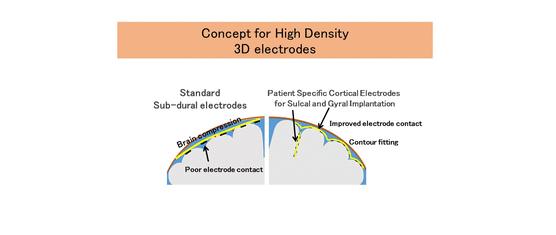Shayne Morris, Masayuki Hirata, Hisato Sugata, Tetsu Goto, Kojiro Matsushita, Takufumi Yanagisawa, Youichi Saitoh, Haruhiko Kishima, and Toshiki Yoshimine, Osaka University Medical School, Osaka, Japan
Volume 62, Issue 4, Page:1034-1041 Open Access

Non-invasive localization of certain brain functions may be mapped on a millimeter level. However, the inter-electrode spacing of common clinical brain surface electrodes still remains around 10 mm. Using 3D-printer technologies, we developed personalized electrodes designed to fit the contoured surface and inside the central sulcus of an individual patient’s brain with the purpose of attaining higher quality electrocorticographic signals for use in functional brain mapping and brain-machine interface (BMI) technologies, including the control of robotic arms and computers purely through the use of thought. To achieve this, we produced sheet electrodes through a press system that sandwiched the electrodes between personalized silicone sheets after the creation of individualized molds utilizing the patient’s MRI information, CAD, and a 3D-printer. We designed 2 types of electrode sheets. The gyral sheet electrode was designed to match the surface of the brain, with particular emphases on higher electrode densities over the more anatomically important areas, while the sulcal sheet electrode had electrodes on both sides and was designed to be inserted into the central sulcus, a region that has been reported to provide higher decoding rates for imagined movement. We were also able to custom design, rapidly manufacture, safely implant and confirm the efficacy of personalized electrodes, including the ability to attain meaningful high gamma-band information in an amyotrophic lateral sclerosis (ALS) patient, indicating the efficacy of tailor-made high spatial resolution 3D cortical sheet electrodes. These electrodes may contribute to the higher performance of BMI’s.
Keywords: brain mapping, brain-machine interface (BMI), 3D printer, 3D sub-dural electrodes, amyotrophic lateral sclerosis (ALS)

